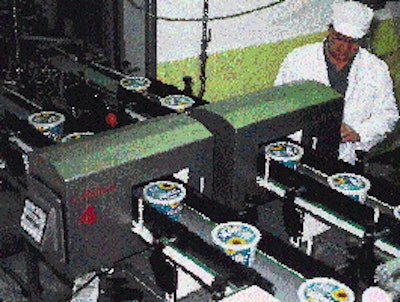
Both systems are supplied by Safeline U.K. (U.S. office: Tampa, FL). Commissioned in January '95, the line produces 500-g and 1-kg tubs. Unique in itself is the twin-lane detector, downstream from lidding. While the Liverpool plant already had four single-lane detectors on other packaging lines, the speed of the new line was so high it required a dual-lane solution. Kraft won't identify the line speed. In operation, tubs travel on twin tabletop chain conveyors through the detectors. Ferrous and nonferrous metals can be detected in sizes as small as 1.2 mm, and nonmagnetic stainless steel can be detected down to 2-mm particles. Even split in half, the throughput was high enough for Kraft to insist on a guarantee from Safeline that the tub in which metal is detected will be the one that's ejected off the line by high-speed diverters. That required special tracking techniques, which Safeline refers to as "photogated registration," to lock onto the correct tub if metal has been detected. The technique involves a photocell feeding a signal into the PLC on the detector, although Safeline declines to reveal specifics, beyond saying it does not involve timing belt speeds. The twin-lane detector is also unique in that the two units are no more than 4" apart, due to tight space constraints at the Liverpool facility. Safeline uses certain proprietary techniques, in addition to shielding, to prevent crosstalk, or interference. Otherwise, the detectors would have to be placed 6' or more apart. A pipeline detector, often used for liquids or slurries, was installed upstream for added insurance. By inspecting product as it's pumped into the filler, Kraft can protect the delicate filling head from potential metal fragments, eliminating unwanted downtime for repairs. The system consists of a miniature metal detector with a 3"-dia throughput pipe and integral three-way valve that briefly diverts product flow when metal contamination is detected. A built-in performance validation routine on each detector ensures periodic testing of the detectors is carried out by Kraft quality assurance personnel at Kraft-designated time intervals. Once a detector has indicated a test is due, authorized Kraft personnel must enter a security code on the detector keypad and conduct a test involving passing certified ferrous and stainless steel test samples through the aperture. With metal detection both prior to and after filling, plus the built-in performance validation routine feature, Kraft is better able to meet its rigorous QA procedures without limiting its high-speed production.

























